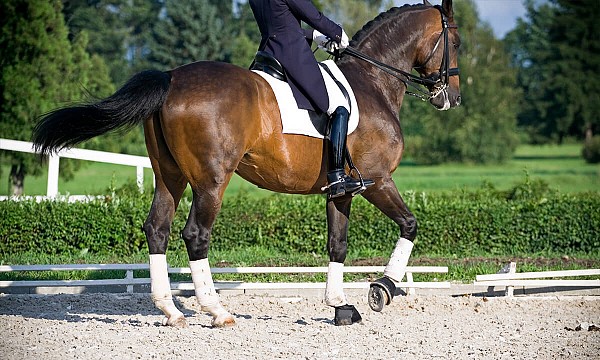- Learn and practice your test
Even if you have a caller on the day, learn the test beforehand, practice riding individual parts of the test and ride the whole test a couple of times. Don't practice riding the whole test too many times or your horse may anticipate movements on the day. On a windy day and/or with a lot of background noise you don't want to be left wondering where to go if you can't hear your caller - think of the caller as a back up against forgetting the test on the day, but don't be totally reliant on them. - Relax
Take a few deep breaths and relax your body before entering the arena. A tense rider will make a tense horse. Remember it is supposed to be fun! - Look up
Look up and ahead of you so you can plan and prepare for your transitions and turns - it also helps with your posture and position. If you need to look down then do so with your eyes but not your head. - Ride forward on straight lines
Ensure your horse is going actively forward in an even rhythm (but not rushing) on the straight lines as a horse that is lacking impulsion as you ride down the centre line or across the school is more likely to drift from side to side. - Prepare for transitions
Half halt before each upward and downward transition to prepare your horse for the transition and help to keep it balanced through the transition. - Give yourself more time when riding transitions between markers
Ask for the transition 2-3 strides after your horse has passed the first marker so the judge can see that you are clearly past the first marker whilst you allow your horse the maximum amount of time to respond to your aids for the transition before reaching the second marker. If you ask for the transition half way between the markers or as you approach the second marker you give your horse less time to respond to your aids and run the risk of performing the transition too late if your horse is slow to respond. - Prepare for turns
Half halt before each turn across the arena to prepare your horse for the turn and keep the inside leg close and pushing into the outside rein contact as you turn to prevent the horse falling in and help it balance through the turn. Look ahead of you around your turn. - Ride good circles
Picture the circle drawn on the arena surface and ride along its imaginary line and look 1/4 to 1/2 circle ahead as you ride to ensure you ride a good even circle. - Ride a good free walk
The free walk carries double marks and the judge is looking for a good stretch down with the neck and a longer stride. Keep your hands low to encourage stretching down of the neck as you allow the horse to take the reins forward and let them slip through your fingers. Do not just throw the reins away and drop the contact altogether, the horse must take the contact forward. Alternate squeezing with each leg as each side of the horse's body swings down to encourage a longer, active stride. - Don't cut corners
Ride into the corners (but not too deep that your horse loses impulsion, rhythm and balance) as you ride around the arena. There should be a clear difference between riding a corner as you ride around the arena, to riding past the corner when riding a circle at A or C. - Bend correctly
Ensure your horse is bent to the inside on circles, corners and turns. If your horse falls in on circles, corners or turns then half halt and push the horse with your inside leg into your outside rein contact whilst keeping the horse bent to the inside. Don't be tempted to pull the horse out with your outside rein as this will cause the horse to bend to the outside. - Ride a straight halt
As you ask for halt keep your legs close to the horse's body ready to squeeze and block with either leg if you feel the horse start to swing its hindquarters to one side as you halt.



















